Ijraset Journal For Research in Applied Science and Engineering Technology
- Home / Ijraset
- On This Page
- Abstract
- Introduction
- Conclusion
- References
- Copyright
Examining Seismic Response for Rigid Building Frame Having Composite Column
Authors: Jagriti Swarnkar, Mahesh Ram Patel
DOI Link: https://doi.org/10.22214/ijraset.2022.45821
Certificate: View Certificate
Abstract
Concrete filled steel tubes are generally used in Beams, Columns, Piers and caissons for deep foundations. The steel tube functions as the formwork for casting the concrete and hence, construction cost is reduced. The prime focus of the present work is to study the behavior of RCC structure under the effect of seismic loads provided with composite columns. This research study comprises of seismic analysis with the design of rigid frame with Reinforced Concrete column, Concrete encased steel and steel tube encasing concrete columns. These cases are designed based on IS 1893:2016 using ETABS software. The result shows that steel encased concrete is performing better than conventional column. The construction practices is the only difficulty arises in such of composite column.
Introduction
I. INTRODUCTION
Concrete-filled tubes are a dynamic sectional typology that consists of a circular or square-shaped steel tube filled with concrete on the inside as shown in figure below. The combined effect of a ductile material (steel) and a cohesive material (concrete) provides the section with very interesting mechanical properties. Since the 1970s, concrete-filled steel tubes have been used in industrial facilities in northern China. In workshop or industrial buildings, the column typically resists axial load and bending. For nearly 50 years, concrete-filled steel tubular columns have been used in China. They've been used in a variety of buildings, bridges, and other structures, including a number of industrial facilities (Han & Li, 2014). CFST members' high resistance, stiffness, and beneficial dynamic behavior met the requirements of heavily loaded industrial facilities. A four-story (G+3) RC building structure in Warangal, Telangana State, India, investigated by (Oggu et al., 2020) has been chosen as a case study. In addition, the structure will be extended vertically by two stories above its current configuration. Visual inspection and nondestructive tests are used to update the structural and material inputs to the analytical model, which is then followed by an analytical study. Self-Compacting Concrete Behavior Filled steel tube (CFST) fabrication located at U.S. Federal Courthouse, Seattle, WA, USA is done by (Sumalatha, 2020).The ultimate load capacity of composite circular hollow steel tubes with different grades of Self Compacting Concrete infill is tested. Steel tubes of various lengths, thicknesses, and grades are compared. The obtained results were compared to those of the American Concrete Institute (ACI), Euro Code-4 (EC-4) and modelling was done using the FL (Fuzzy Logic) technique, which is a soft tool in Matlab-R2018b. Guwahati, in north-east India, is in seismic zone V and is located in the Assam gap of the Himalaya. The study also supplements India's earthquake-resistant building codes and guidelines for new building construction (Ghione et al., 2021; Sarmah & Das, 2018). They were tailored and graded in accordance with (FEMA365, 2000) guidelines, which are more comprehensive when dealing with other building structures. The findings will be useful in developing local policy to arrange the building stock for appropriate remedial measures. The current practices of selection and scaling methods available in international codes such as ASCE 7-05, ASCE 7-10, and (ASCE, 2016) are presented and evaluated in this paper. A case study for a far field site in the town of Alipur in the Delhi region is presented. This paper shows how to scale ground motion using spectral acceleration as the intensity measure and amplitude scaling and spectral matching methods on a two-story three-dimensional RCC frame structure (Mulchandani et al., 2018).
II. METHODOLOGY
In this research work, case study of building considered originally located in Warangal, Telangana, India is carried for modelling in which RCC, Concrete Encased Steel and Steel Encased Concrete Column is been analyzed carried by Seismic Zone-III using ETABS software. Building responses of the structure are computed and then compared with the other cases. Loads considered are taken in accordance with the IS-875 (Part1 & Part2), IS-1893:2002/2016 & load combinations are according to IS-875(Part5).
A. Structural Details
The following below is the detail of Case Study to be analyzed in the investigation-
Table 1 Proposed Model Cases for the Research Study
|
Description |
G+3 |
G+8 |
|
Building with Conventional RCC Column |
RC1 |
RC3 |
|
Building with 4.2 m height Conventional RCC Column at ground storey |
RC2 |
RC4 |
|
Building with Concrete Encased Steel Column |
CF1 |
CF3 |
|
Building with 4.2 m height Concrete Encased Steel Column at ground Storey |
CF2 |
CF4 |
|
Building with Steel Encased Concrete Column |
SE1 |
SE3 |
|
Building with 4.2 m height Steel Encased Concrete Column at ground Storey |
SE2 |
SE4 |
Note: The cases are categorized in two groups in which first group is of (G+3) building frame and second group is of (G+8) building frame.
The data of structure used in this thesis is in the form of tabulation considered for design and analysis of frame are given below-
Table 2 Structural Specification for the study
|
PARTICULARS |
STRUCTURAL PROPERTIES |
|
Reference Model (Case Study) Location |
Warangal, Telangana, India |
|
Total Built-Up Area |
57.5 X 17.5 m |
|
Number of Stories |
G+3, G+8, G + 13 |
|
Nominal Floor to floor Height |
3.2 m |
|
Size of Columns |
230X 530 mm, 300 X 610 mm |
|
Beam Size |
230 X 430 mm, 230 X 480 mm, 280 X 640 mm |
|
Slab thickness |
100 mm |
|
Dead load |
IS 875 Part-1 |
|
Live load |
IS 875 Part-2 |
|
Roof live load |
IS 875 Part-2 |
|
Earthquake load |
(IS 1893 (Part 1), 2016) |
B. Description of Model Cases of the Study
The grid lines drawn is non-uniform throughout the length and width of the building.The building shown below is asymmetry model taken first by Praveen Oggu et.al (2020) in which there are 18 bays having varying center to center distance of 2.4 m , 3 m, 3.5m , 3.7m along Y-axis and there are 5 bays having varying center to center distance of 3.5m , 4.2 m , 5.9m, along X-axis. The total length along X-axis is about 17.5 m. The length along Y-axis is 57.5 m. This cases signifies that RCC frame building with uniform storey height having conventional RCC slab having thickness 100 mm.
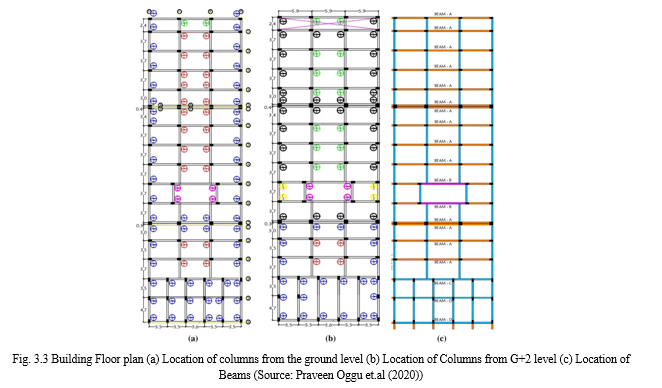
- Model Based on Conventional RCC Column: The columns applied in models are made with conventional RCC material with Case RC1, RC3 having nominal height of storey about 3.2 m for both (G+3 and (G+8) building frames. Later, the model RC2 and RC4 is made with column height 4.2 m at the ground storey only and the rest having nominal height 3.2 m for both (G+3 and (G+8) building frames.
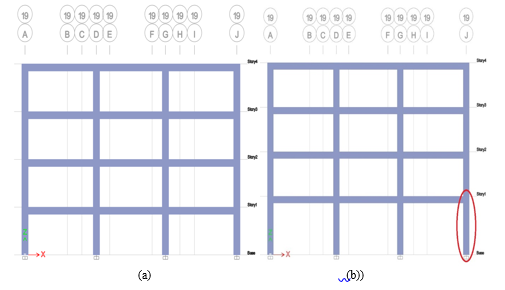
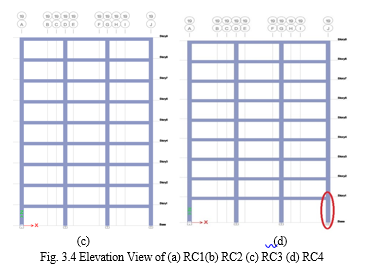
2. Based on Concrete Encased Steel Column: The building having (G+3), (G+8) storey are categorized as the building frame with CF1, CF3 respectively have composite column (concrete encased steel) with nominal height of storey about 3.2 m. Similarly, the model having concrete encased columns with 4.2 m height column at the ground storey and the rest storey have 3.2 m column height represents as CF2 and CF4 model.
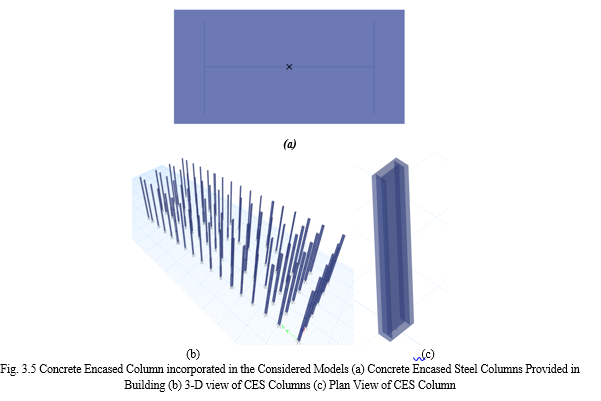
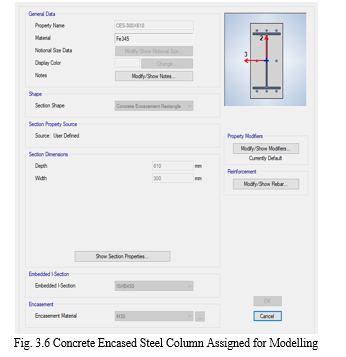
3. Model Based on Steel Encased Concrete Column: The building having (G+3), (G+8) storey are categorized as the building frame with SE1, SE3 respectively have composite column (steel encased concrete) with nominal height of storey about 3.2 m. Similarly, the model having concrete encased columns with 4.2 m height column at the ground storey and the rest storey have 3.2 m column height represents as SE2, SE4.
.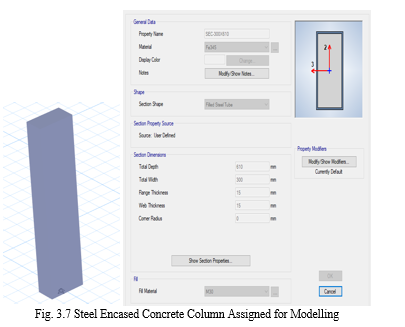
III. LOADING SPECIFICATION & CALCULATIONS COMMON FOR ALL FRAMES USED IN SOFTWARE
The loads which are to be applied in the project is discussed under following clauses below in which their calculation detail is also been discussed such as Primary load, Seismic Load & their load combination etc.
A. Primary Loads Applied for Analysis
In Software, the loads are taken in the form of load cases i.e., primary load cases and the load combination of primary load cases also which are used same for all frame buildings. Firstly, here are the primary load cases which have been used in ETABS software analysis are given below in table 3.4 with their load type & numbers-
Table 3 Primary Load Cases
|
Load Case Number |
Load Type |
Name |
|
1 |
Dead Load |
DL |
|
2 |
Live Load |
LL |
|
3 |
Seismic Dynamic Load |
RSAX |
|
4 |
Seismic Dynamic Load |
RSAY |
Load Calculations Used for All Frame Cases
The calculated load acting on the structures of dead load, floor live load, roof live load is given below-
1. Dead Load (D.L)
In this analysis, dead load includes dead load of the slab, dead load of beam & column, dead load of external walls and dead of internal walls. DEAD LOAD is designated as D.L in ETABS. Self-Weight of Slab/Plate = (unit weight of concrete X thickness of slab) = 25 X 0.10 = 2.5 KN/m2
The floor finish load is considered as dead load and applied in the slab. The value of floor finish is 1 KN/m2. The roof treatment load considered as dead load and assigned in the slab. The value of Roof treatment is 1.5 KN/m2. The Outerwall is taken 230 mm thick and inside wall is taken as 150 mm thick. The wall load is considered as dead load.
Self-Weight of Outer Wall = (unit weight of concrete X dimension of wall) = 20 X 0.23 X 3.2 = 14.72 KN/m
Self-Weight of Inner Wall = (unit weight of concrete X dimension of wall) = 20 X 0.15 X 3.2 = 9.6 KN/m
2. Live Load (L.L)
In this research, live load includes live load for all the floors as it is considered from the commercial building category given in IS 875 Part -2 and live load for roof is also considered from same above code. LIVE LOAD is designated as L.L. Here Live load for all the floors considered for the study is 3 KN/m2.
IV. RESULTS AND DISCUSSION
A. Displacement Report
Table 4 Displacement value for (G+3) building frame
|
Storey |
Displacement for RC1 (mm) |
Displacement for RC2 (mm) |
Displacement for CF1 (mm) |
Displacement for CF2 (mm) |
Displacement for SE1 (mm) |
Displacement for SE2 (mm) |
|
Storey 4 |
17.546 |
18.527 |
16.092 |
17.766 |
10.837 |
12.921 |
|
Storey 3 |
14.305 |
15.764 |
12.975 |
14.972 |
8.667 |
10.794 |
|
Storey 2 |
9.454 |
11.607 |
8.465 |
10.845 |
5.587 |
7.696 |
|
Storey 1 |
4.076 |
6.438 |
3.384 |
5.788 |
2.19 |
3.982 |
Table 5 Displacement value for (G+8) building frame
|
Storey |
Displacement for RC3 (mm) |
Displacement for RC4 (mm) |
Displacement for CF3 (mm) |
Displacement for CF4 (mm) |
Displacement for SE3 (mm) |
Displacement for SE4 (mm) |
|
Storey9 |
23.329 |
24.878 |
22.254 |
23.703 |
17.883 |
18.99 |
|
Storey8 |
22.26 |
23.844 |
21.24 |
22.72 |
17.14 |
18.276 |
|
Storey7 |
20.704 |
22.358 |
19.751 |
21.291 |
15.987 |
17.174 |
|
Storey6 |
18.615 |
20.368 |
17.744 |
19.367 |
14.385 |
15.641 |
|
Storey5 |
16.059 |
17.934 |
15.273 |
17 |
12.373 |
13.712 |
|
Storey4 |
13.092 |
15.107 |
12.396 |
14.241 |
10.002 |
11.432 |
|
Storey3 |
9.772 |
11.933 |
9.176 |
11.137 |
7.34 |
8.849 |
|
Storey2 |
6.182 |
8.458 |
5.709 |
7.743 |
4.495 |
6.031 |
|
Storey1 |
2.517 |
4.636 |
2.242 |
4.073 |
1.724 |
3.063 |
Conclusion
The displacement for building having RCC column showing larger displacement value as compared to the composite columns. It has been seen that RC1 (RCC column) is 26.35% more than the SE2 (steel encased column). As, the building frame height increases from (G+3) to (G+8) then there is increase in displacement by 32% which shows that increase in height of building led to increase in displacement irrespective of column material.
References
[1] ASCE. (2016). Minimum Design Loads and Associated Criteria for Buildings and Other Structures. In AMERICAN SOCIETY OF CIVIL ENGINEERS. https://doi.org/10.1061/9780872629042 [2] FEMA365. (2000). Prestandard and commentary for the seismic rehabilitation of buildings. November. [3] Ghione, F., Poggi, V., & Lindholm, C. (2021). A hybrid probabilistic seismic hazard model for Northeast India and Bhutan combining distributed seismicity and finite faults. Physics and Chemistry of the Earth, Parts A/B/C, 123, 103029. [4] Han, L.-H., & Li, W. (2014). Seismic Performance of Concrete-Filled Steel Tubular (CFST) Structures. In Seismic Design of Industrial Facilities (pp. 361–368). Springer. [5] IS 1893 (Part 1). (2016). IS 1893 (Criteria for Earthquake resistant design of structures,Part 1:General Provisions and buildings). Bureau of Indian Standards, New Delhi, December, 1–44. [6] Mulchandani, H. K., Muthukumar, G., & Bansal, S. (2018). Ground motion selection and scaling using ASCE 7-16, case study on Town Alipur in Delhi Region. 16th Symposium on Earthquake Engineering December, India. [7] Oggu, P., Gopikrishna, K., & Sewaiwar, S. (2020). Seismic assessment of existing gravity load-designed RC framed building: a case study from Warangal, India. SN Applied Sciences, 2(5), 1–13. https://doi.org/10.1007/s42452-020-2690-7 [8] Sarmah, T., & Das, S. (2018). Earthquake vulnerability assessment for RCC buildings of Guwahati City using rapid visual screening. Procedia Engineering, 212, 214–221. [9] Sumalatha, N. K. (2020). ANALYTICAL STUDIES ON CFST COLUMNS ( SCC INFILLED ) USING FUZZY LOGIC. Journal of Emerging Technologies and Innovative Research (JETIR), 7(4), 1168–1176. https://www.jetir.org/
Copyright
Copyright © 2022 Jagriti Swarnkar, Mahesh Ram Patel. This is an open access article distributed under the Creative Commons Attribution License, which permits unrestricted use, distribution, and reproduction in any medium, provided the original work is properly cited.

Download Paper
Paper Id : IJRASET45821
Publish Date : 2022-07-20
ISSN : 2321-9653
Publisher Name : IJRASET
DOI Link : Click Here
 Submit Paper Online
Submit Paper Online

